Olga's Gallery
Dear Friends of Art,
This month millions of Christians all over the world celebrate Easter,
the feast of the Passion, Death on the cross, and Resurrection of Our Savior.
These events, narrated in all four Gospels, found their reflection
in numerous paintings of many artists. Besides the Gospels there were also
the stories of common people, who either witnessed the events or heard
about them. There were stories about Virgin Mary and Christ's family, about
the lives of the Apostles, about courageous people who died for their Christian
faith and were considered Saints by the Church. All those stories were
orally passed from generation to generation and in time formed a variety
of different legends, which around 1260 were compiled together by a Dominican,
Jacobus de Voragine, a scholarly friar and eventual archbishop of Genoa.
His book, The Golden Legend, was very popular in the Middle Ages and was
perhaps the most widely read book, after the Bible.
The Legend of the True Cross
The Legend of the True Cross is also part of the Golden Legend. The Cross, on which Christ was crucified and died, became for Christians the object of a special respect and worship, not only as a remembrance of His sufferings and death, but also as a symbol of His sacrifice.
Quite naturally, the Cross has its own body of wonderful stories, which gave inspiration to many works of art. The best known "illustration" is a cycle of frescoes in the Basilica di San Francesco in Arezzo, Italy by the master of Early Renaissance Piero della Francesca (c.1420-1492).
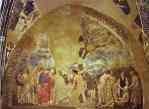 The
fresco cycle starts with the dying Adam, humanity's ancestor, sending one
of his sons, Seth, to Archangel Michael, who presented the son with a seed
from the tree of the knowledge of good and evil. On his return Seth placed
the seed into Adam's mouth just before the latter's death.
The
fresco cycle starts with the dying Adam, humanity's ancestor, sending one
of his sons, Seth, to Archangel Michael, who presented the son with a seed
from the tree of the knowledge of good and evil. On his return Seth placed
the seed into Adam's mouth just before the latter's death.
 The
tree grew on Adam's grave. Centuries later it was chopped down, but as
its wood could not be used for anything, the trunk was thrown across a
stream to serve as a bridge. The Queen of Sheba, on her way to the wise
King Solomon, was about to step on the bridge, when she heard a divine
message that the Savior would be crucified on the cross from this wood.
She knelt in veneration. Then the Queen hurried to the King Solomon to
tell him about her vision.
The
tree grew on Adam's grave. Centuries later it was chopped down, but as
its wood could not be used for anything, the trunk was thrown across a
stream to serve as a bridge. The Queen of Sheba, on her way to the wise
King Solomon, was about to step on the bridge, when she heard a divine
message that the Savior would be crucified on the cross from this wood.
She knelt in veneration. Then the Queen hurried to the King Solomon to
tell him about her vision.
![]() The
wise King Solomon understood the prophecy – the death of the Savior on
the cross would cause the end of the kingdom of the Jews, the kingdom of
his people – and trying to prevent the events ordered the wood to be hidden.
The
wise King Solomon understood the prophecy – the death of the Savior on
the cross would cause the end of the kingdom of the Jews, the kingdom of
his people – and trying to prevent the events ordered the wood to be hidden.
But Solomon's precautions did not help – centuries later the wood was found and Jesus was crucified on a Cross made of it.
![]() Three
centuries later two Roman Emperors, Constantine and Maxentius, were struggling
for power over the Roman Empire. Just before their decisive battle Constantine
received a message in his dream that he would be the victor if he converted
to Christianity. Constantine went into the battle a Christian and won.
Three
centuries later two Roman Emperors, Constantine and Maxentius, were struggling
for power over the Roman Empire. Just before their decisive battle Constantine
received a message in his dream that he would be the victor if he converted
to Christianity. Constantine went into the battle a Christian and won.
![]()
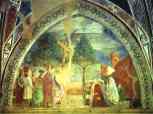 Constantine's
mother, Helena, after her son's victory went into the Holy Land with the
purpose of seeing all the Holy places and find the True Cross. In Jerusalem
only one man, a Jew called Judas, knew the whereabouts of the Cross; he
revealed the secret after torture and brought Helena to a temple of Venus
under which there were all three crosses of Calvary.
Constantine's
mother, Helena, after her son's victory went into the Holy Land with the
purpose of seeing all the Holy places and find the True Cross. In Jerusalem
only one man, a Jew called Judas, knew the whereabouts of the Cross; he
revealed the secret after torture and brought Helena to a temple of Venus
under which there were all three crosses of Calvary.
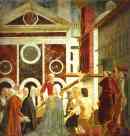 The
True Cross exposed itself by the miraculous resurrection of a dead youth.
The
True Cross exposed itself by the miraculous resurrection of a dead youth.
 Another
three centuries passed. In 610 A.D. King Chosroes II of Persia invaded
the lands of Byzantium and captured one by one its regions in the Middle
East – Anatolia, Syria and Palestine. In the spring of 614 A.D. Persians
captured Jerusalem. Tens of thousands of Christians were massacred and
sold into slavery. The sacred relics of the city, the True Cross and the
instruments of the Passion, have been hidden, but they were unearthed and
were sent eastwards as a gift to the Christian Queen of Persia, Meryem.
The Persians wars lasted for 19 years. Only in December of 627 A.D. Heraclius,
the Byzantine emperor, defeated Chosroes. According to the legend during
the battle the Christians captured and liberated the Cross (According to
history, the Cross was returned by Chosroes' heir who signed peace treaty
with Byzantium.) In August of 629 A.D. Hiraclius celebrated his triumph
in Constantinople. Next spring he journeyed to Jerusalem to return the
Cross there.
Another
three centuries passed. In 610 A.D. King Chosroes II of Persia invaded
the lands of Byzantium and captured one by one its regions in the Middle
East – Anatolia, Syria and Palestine. In the spring of 614 A.D. Persians
captured Jerusalem. Tens of thousands of Christians were massacred and
sold into slavery. The sacred relics of the city, the True Cross and the
instruments of the Passion, have been hidden, but they were unearthed and
were sent eastwards as a gift to the Christian Queen of Persia, Meryem.
The Persians wars lasted for 19 years. Only in December of 627 A.D. Heraclius,
the Byzantine emperor, defeated Chosroes. According to the legend during
the battle the Christians captured and liberated the Cross (According to
history, the Cross was returned by Chosroes' heir who signed peace treaty
with Byzantium.) In August of 629 A.D. Hiraclius celebrated his triumph
in Constantinople. Next spring he journeyed to Jerusalem to return the
Cross there.
Piero della Francesca finished his fresco cycle with this story, but history of the True Cross did not stop.
At the end of the forth century A.D. St. Cyril of Alexandria left a description of the ceremony of the True Cross veneration on Good Friday in Jerusalem, when all the faithful assembled in the Chapel of the Cross, built on a site of Calvary. St. Cyril also left the important evidence, that relics of the True Cross were distributed all over the Christian world and were highly valued.
In 1187 the great Muslim warrior Saladin (Salah ed-Din Yusuf) defeated the Christian knights in the decisive battle at Karnei-Hattin (Horns of Hattin) in Galilee (territory of modern Israel) and ended the rule of Christians over the Holy Land forever. The True Cross, which the knights had taken out of its chapel in Jerusalem and brought with them into the battle, vanished. Its further destiny is unknown, but the fragments of the True Cross were kept through centuries as most precious gifts.
One of the relics of the True Cross found its way to Venice and the wonderful miracles, which it performed, were commemorated by different Venetian artists, specialists in narrative painting.
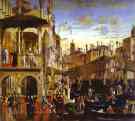 One
of the episodes, The Healing
of a Madman, took place in Venice in 1494, and was represented
by Vittore Carpaccio (1455/60-1525/26).
The miracle takes place on the roof terrace on the left, but the greater
part of the canvas depicts contemporary Venice with accurate portrayal
of the Grand Canal and the Rialto Bridge still built out of wood.
One
of the episodes, The Healing
of a Madman, took place in Venice in 1494, and was represented
by Vittore Carpaccio (1455/60-1525/26).
The miracle takes place on the roof terrace on the left, but the greater
part of the canvas depicts contemporary Venice with accurate portrayal
of the Grand Canal and the Rialto Bridge still built out of wood.
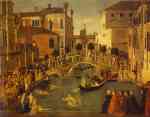 Gentile
Bellini (c. 1429-1507) painted The
Recovery of the Relic of the True Cross. Vasari reported on
the event, which gave rise to the painting in the following way: “By what
chance I know not, the fragment had fallen from the Ponte della Paglia
into the canal, and in their veneration for the holy wood of the Cross
of Christ, numerous people plunged into the water; it was however the Will
of God that none other than the master of the Fraternity (Andrea Vendramin)
was found worthy to recover it…” Among the spectators Gentile depicted
Catarina Cornaro, Queen of Cyprus, accompanied by the ladies of her court
(on the left-hand side of the picture). In the foreground on the right-hand
side are the masters of the Scuola or confraternity of St. John the Evangelist
in Venice. Gentile has included himself in this group, along with his brother
Giovanni (third and forth from left).
Gentile
Bellini (c. 1429-1507) painted The
Recovery of the Relic of the True Cross. Vasari reported on
the event, which gave rise to the painting in the following way: “By what
chance I know not, the fragment had fallen from the Ponte della Paglia
into the canal, and in their veneration for the holy wood of the Cross
of Christ, numerous people plunged into the water; it was however the Will
of God that none other than the master of the Fraternity (Andrea Vendramin)
was found worthy to recover it…” Among the spectators Gentile depicted
Catarina Cornaro, Queen of Cyprus, accompanied by the ladies of her court
(on the left-hand side of the picture). In the foreground on the right-hand
side are the masters of the Scuola or confraternity of St. John the Evangelist
in Venice. Gentile has included himself in this group, along with his brother
Giovanni (third and forth from left).
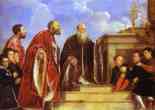 Titian
(1488/90 - 1576) depicted The
Vendramin Family. A relic of the True Cross encased in
Venetian crystal stands on an open-air altar, being adored by the Vendramin
family. The relic was presented in 1369 to the aforesaid Andrea Vendramin,
the master of the Scuola or confraternity of St. John the Evangelist in
Venice, and still exists. Titian's picture was probably commissioned in
c. 1543 by Andrea’s 16th-century namesake, kneeling by the altar, and his
brother, Gabriel Vendramin, stooping in veneration. On either side are
Andrea’s seven sons. The presence of the 14th-century Andrea Vendramin
who first witnessed the miracle of the True Cross is alluded to by presence
of the relic.
Titian
(1488/90 - 1576) depicted The
Vendramin Family. A relic of the True Cross encased in
Venetian crystal stands on an open-air altar, being adored by the Vendramin
family. The relic was presented in 1369 to the aforesaid Andrea Vendramin,
the master of the Scuola or confraternity of St. John the Evangelist in
Venice, and still exists. Titian's picture was probably commissioned in
c. 1543 by Andrea’s 16th-century namesake, kneeling by the altar, and his
brother, Gabriel Vendramin, stooping in veneration. On either side are
Andrea’s seven sons. The presence of the 14th-century Andrea Vendramin
who first witnessed the miracle of the True Cross is alluded to by presence
of the relic.
The relics of the True Cross still exist and are venerated by many Christians. Some skeptics joke that it is possible to build a battle ship out of all the pieces. In 1870 Rohault de Fleury published "Mémoire sur les instruments de la Passion" (Paris, 1870), in which he tried to trace all the relics of the True Cross and drew up a catalogue of them. The author ascertained that all the known relics, put together, would not reach one-third of a cross which has been supposed to have been three or four meters in height, with transverse branch of two meters.
We can't and don't want to judge whether all the venerated relics are really the fragments of the True Cross or not. The True Cross is a part of our history, including the history of art.
Happy Easter!
Bibliography:
A History of the Crusades by Steven Runciman. The Folio Society.
London. 1994.
The
Golden Legend by Jacobus De Voragine, William Granger Ryan
(Translator). Princeton Univ Pr, 1995.
The
Cambridge Companion to Piero della Francesca by Jeryldene M.
Wood (Editor). Cambridge Univ Pr, 2002.
Piero
Della Francesca: The Legend of the True Cross in the Church of San Francesco
in Arezzo by Piero, Carlo Bertelli (Editor), Marilyn Aronberg
Lavin, Maria Teresa Donati, Alessandro Benci (Photographer), Anna Marie
Maetzke (Editor). Skira, 2002.
Catholic Encyclopedia
- The True Cross